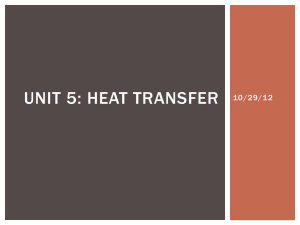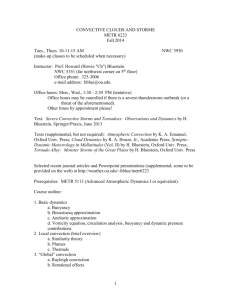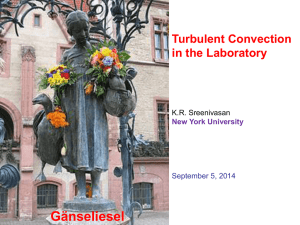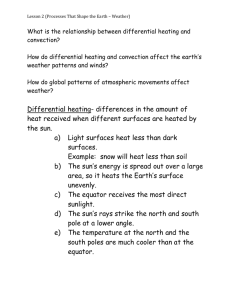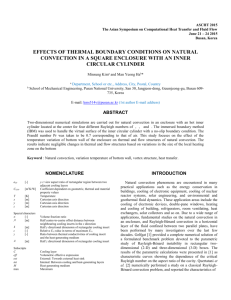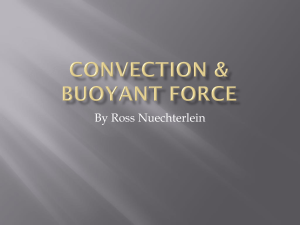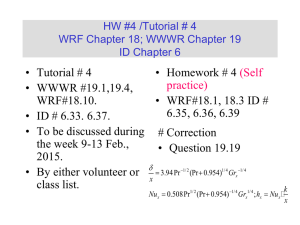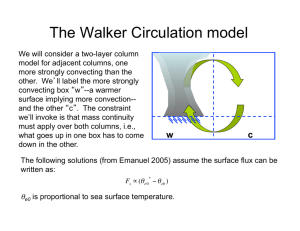Introduction Natural convection has many industrial and geophysical
advertisement
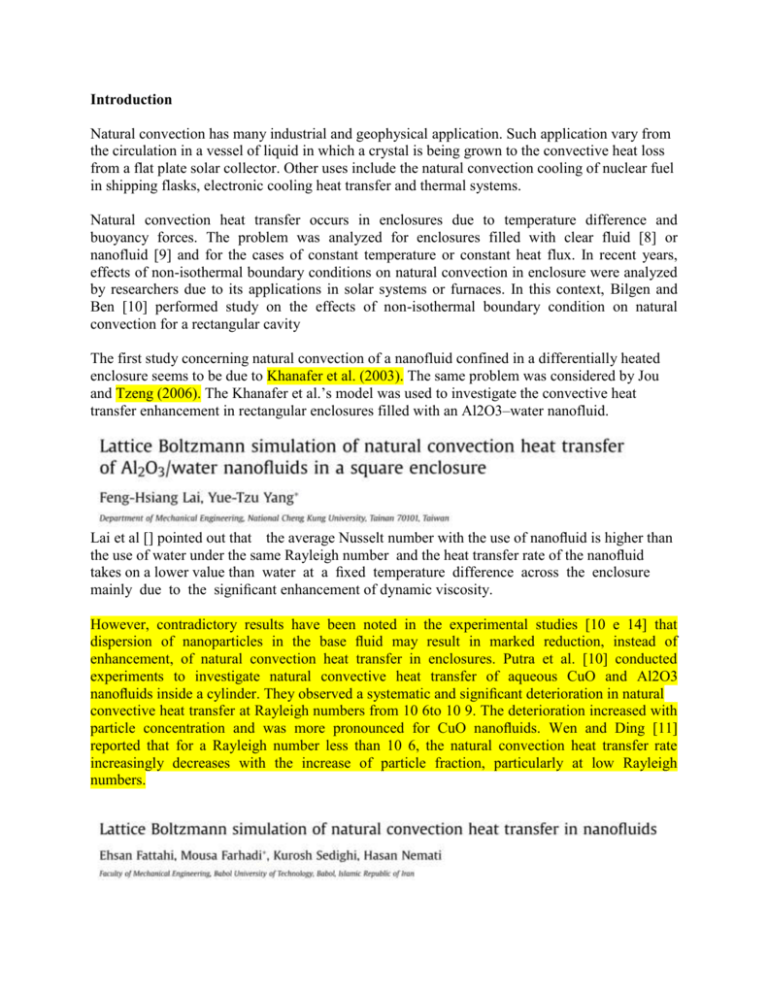
Introduction Natural convection has many industrial and geophysical application. Such application vary from the circulation in a vessel of liquid in which a crystal is being grown to the convective heat loss from a flat plate solar collector. Other uses include the natural convection cooling of nuclear fuel in shipping flasks, electronic cooling heat transfer and thermal systems. Natural convection heat transfer occurs in enclosures due to temperature difference and buoyancy forces. The problem was analyzed for enclosures filled with clear fluid [8] or nanofluid [9] and for the cases of constant temperature or constant heat flux. In recent years, effects of non-isothermal boundary conditions on natural convection in enclosure were analyzed by researchers due to its applications in solar systems or furnaces. In this context, Bilgen and Ben [10] performed study on the effects of non-isothermal boundary condition on natural convection for a rectangular cavity The first study concerning natural convection of a nanofluid confined in a differentially heated enclosure seems to be due to Khanafer et al. (2003). The same problem was considered by Jou and Tzeng (2006). The Khanafer et al.’s model was used to investigate the convective heat transfer enhancement in rectangular enclosures filled with an Al2O3–water nanofluid. Lai et al [] pointed out that the average Nusselt number with the use of nanofluid is higher than the use of water under the same Rayleigh number and the heat transfer rate of the nanofluid takes on a lower value than water at a fixed temperature difference across the enclosure mainly due to the significant enhancement of dynamic viscosity. However, contradictory results have been noted in the experimental studies [10 e 14] that dispersion of nanoparticles in the base fluid may result in marked reduction, instead of enhancement, of natural convection heat transfer in enclosures. Putra et al. [10] conducted experiments to investigate natural convective heat transfer of aqueous CuO and Al2O3 nanofluids inside a cylinder. They observed a systematic and significant deterioration in natural convective heat transfer at Rayleigh numbers from 10 6to 10 9. The deterioration increased with particle concentration and was more pronounced for CuO nanofluids. Wen and Ding [11] reported that for a Rayleigh number less than 10 6, the natural convection heat transfer rate increasingly decreases with the increase of particle fraction, particularly at low Rayleigh numbers. Fattahi et al () showed the effects of solid volume fraction of nanofluids on hydrodynamic and thermal characteristics are investigated and discussed. It is found that the effects of solid volume fraction for Cu are stronger than Al2O3. Lattice Boltzmann method (LBM) is an ideal mesoscopic approach to solve nonlinear macroscopic conservation equations because of its simplicity and ease for parallelization. For incompressible isothermal flows, the LBM is found to be at least as stable, accurate and computationally efficient, as traditional computational methods [1,2] and has achieved excellent success in different application areas such as multiphase flow and complex fluid phenomena [3]. Mathematical model and simulation methodology References [8] J.A. Eastman, U.S. Choi, S. Li, W. Yu, L.J. Thompson, Anomalously increased effective thermal conductivity of ethylene glycol-based nanofluids containing copper nanoparticles, Appl. Phys. Lett. 78 (2001) 718–720. [9] H.F. Oztop, E. Abu-Nada, Numerical study of natural convection in partially heated rectangular enclosure filled with nanofluids, Int. J. Heat Fluid Flow 29 (2008) 1326–1336. [10] E. Bilgen, Y.R. Ben, Natural convection in enclosure with heating and cooling by sinusoidal temperature profiles on one side, Int. J. Heat Mass Transfer 50 (2007) 139–150. [] Khanafer, K., K. Vafai and M. Lightstone, “Buoyancy-Driven Heat Transfer Enhancement in a Two-Dimensional Enclosure Utilizing Nanofluids,” Int. J. Heat Mass Transfer 46, 3639–3653 (2003). [] Jou, R. Y. and S. C. Tzeng, “Numerical Research of Nature Convective Heat Transfer Enhancement Filled With Nanofluids in Rectangular Enclosures,” Int. Commun. Heat Mass Transfer 33, 727–736 (2006). [] Feng-Hsiang Lai, Yue-Tzu Yang, Lattice Boltzmann simulation of natural convection heat transfer of Al2O3/water nanofluids in a square enclosure, International Journal of Thermal Sciences, Volume 50, Issue 10, October 2011, Pages 1930-1941, [] N. Putra, W. Roetzel, S.K. Das, Natural convection of nano-fluids, Heat and Mass Transfer 39 (2003) 775 e 784. [] D. Wen, Y. Ding, Formulation of nanofluids for natural convective heat transfer applications, International Journal of Heat and Fluid Flow 26 (2005) 855 e 864. [] A.G.A. Nnanna, Experimental model of temperature-driven nanofluid, ASME Journal of Heat Transfer 129 (2007) 697 e 704. [] C.H. Li, G.P. Peterson, Experimental studies of natural convection heat transfer of Al2O3/DI water nanoparticle suspensions (nanofluids), Advances in Mechanical Engineering (2010) Article ID 742739. [] C.J. Ho, W.K. Liu, Y.S. Chang, C.C. Lin, Natural convection heat transfer of alumina-water nanofluid in vertical square enclosures: an experimental study, International Journal of Thermal Sciences 49 (2010) 1345 e 1353. [] Ehsan Fattahi, Mousa Farhadi, Kurosh Sedighi, Hasan Nemati, Lattice Boltzmann simulation of natural convection heat transfer in nanofluids, International Journal of Thermal Sciences, Volume 52, February 2012, Pages 137-144,
